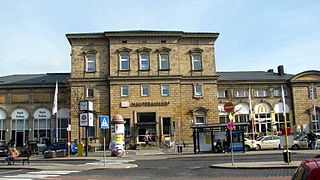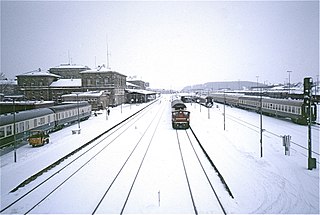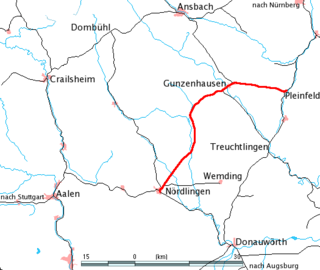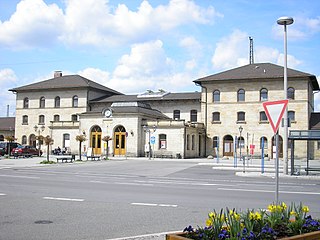Related Research Articles

Franconia is a region of Germany, characterised by its culture and East Franconian dialect . Franconia is made up of the three Regierungsbezirke of Lower, Middle and Upper Franconia in Bavaria, the adjacent, Franconian-speaking, South Thuringia, south of the Thuringian Forest—which constitutes the language boundary between Franconian and Thuringian—and the eastern parts of Heilbronn-Franconia in Baden-Württemberg.

Bayreuth Hauptbahnhof is the main railway station in the German town of Bayreuth, in northern Bavaria.

Pommersfelden is a community in the Upper Franconian district of Bamberg in Germany.
The Nuremberg–Erfurt high-speed railway is a 191-kilometre-long (119 mi) German high-speed railway, between Nuremberg and Erfurt. The line is listed in Germany's federal transport plan as Verkehrsprojekt Deutsche Einheit Nr.8.1 and is a section of the high-speed route between Berlin and Munich and a section of the line connecting Italy and Scandinavia in the European Union's Trans-European Rail network. It consists of an upgraded line between Nuremberg and Ebensfeld and a new line between Ebensfeld and Erfurt. The journey time between Erfurt and Nuremberg will be reduced to approximately one hour and 20 minutes after completion.
Südostbayernbahn is one of several regional railway networks in Germany owned by Germany's national railway, Deutsche Bahn AG. Since 2001, the network has included the railway hub of Mühldorf which connects 7 major railway lines from Munich, Rosenheim, Freilassing, Burghausen, Simbach am Inn, Passau and Landshut, forming a star-shaped network of lines called Linienstern Mühldorf. SüdostBayernBahn is subordinated to DB RegioNetz Verkehr and DB RegioNetz Infrastruktur.

The Bamberg–Hof railway is a 127 kilometre-long main line that runs through Bavaria in southern Germany. The line runs from Bamberg via Lichtenfels, Kulmbach, Neuenmarkt-Wirsberg and Münchberg to Hof. The section from Hof to Neuenmarkt now forms part of the Saxon-Franconian trunk line.

The Rhein-Sieg-Eisenbahn or RSE is a German company founded by the Verkehrsclub Deutschland and interested private individuals with the primary purpose of saving a threatened industrial line, the Beuel–Großenbusch railway.

The Schweinfurt–Meiningen railway, route number 5240, is a single-tracked main line in the states of Bavaria and Saxony in southern Germany. It is also called the Main-Rhön-Bahn and is listed in the Deutsche Bahn timetable as route (Kursbuchstrecke) 815. The railway has been part of the Erfurt–Schweinfurt route since 1993. Passenger services on the line are provided by DB Regio and the Erfurter Bahn (EB).

The Triptis–Marxgrün railway is a branch line in Germany that runs through the states of Thuringia and Bavaria, and which was originally built and operated by the Prussian state railways. It ran from Triptis via Ziegenrück, Bad Lobenstein and Blankenstein to Marxgrün. The only section still in service today is the stretch of line between Ebersdorf-Friesau and Blankenstein. The Thuringian section is also called the Oberlandbahn ; the Bavarian section the Höllentalbahn.
The Bayreuth–Warmensteinach railway is a branch line in the Bavarian province of Upper Franconia in southern Germany. It is the last still partially intact of the seven branch lines, that formerly served the Fichtel Mountains.

The Franconia Railway is a 180-kilometre-long (110 mi) railway line in the north of the German state of Baden-Württemberg and the Bavarian province of Lower Franconia that links Stuttgart and Würzburg. Its name comes from the fact that the majority of the line runs through Franconia. The first section of the line was opened in 1848 and is one of the oldest lines in Germany. The main line is now electrified and has been almost entirely upgraded to double-tracks.

The Nuremberg-Bamberg line is a German railway connecting the Bavarian city of Nuremberg with Bamberg via Fürth, Erlangen, Forchheim. It is part of the northern section of the Ludwig South-North Railway. It runs along the Regnitz Valley and is one of the important German transport routes. Since 2010 line S1 of the Nuremberg S-Bahn uses the entirety of the line from Nuremberg to Bamberg.

The Nördlingen–Pleinfeld railway is a railway line in Bavaria, Germany that was originally built and operated as part of the Ludwig South-North Railway. It runs in southern Middle Franconia and in northern Swabia from Nördlingen via Gunzenhausen to Pleinfeld and opens up the southern Franconian Lake District, the Hesselberg region and parts of the Nördlinger Ries.

Saxon-Franconian trunk line is a modern term for a double-track railway route between the German cities of Dresden and Nuremberg. It is 390 kilometres long and currently electrified from Dresden to Hof. The concept of the Saxon-Franconian trunk route was developed in the transport policy debate in the 1990s during consideration of direct rail services connecting Dresden and Görlitz with Karlsruhe and Oberstdorf. The term is not traditionally used in relation to the railway lines now described by it.

The Nuremberg–Cheb railway is a 151 km long, non-electrified main line, mainly in the German state of Bavaria. It runs from Nuremberg via Lauf an der Pegnitz, Hersbruck, Pegnitz, Kirchenlaibach, Marktredwitz and Schirnding to Cheb in the Czech Republic. The route is also known as the RightPegnitz line or the Pegnitz Valley Railway (Pegnitztalbahn). It was built as the Fichtel Mountains Railway (Fichtelgebirgsbahn). The Nuremberg–Schnabelwaid section of it is part of the Saxon-Franconian trunk line (Sachsen-Franken-Magistrale).

Lichtenfels station is in the town of Lichtenfels in Upper Franconia in the German state of Bavaria. It is a regional rail hub and a former ICE stop on the Hamburg–Berlin Munich route and is classified by Deutsche Bahn as a station of category 3.
The Nuremberg–Schwandorf railway is a 93.7 km long railway from Nuremberg, running along the Pegnitz river, to Hersbruck and continuing via Neukirchen bei Sulzbach-Rosenberg and Amberg to Schwandorf in the German state of Bavaria. It runs parallel to the Nuremberg–Cheb line between Nuremberg and Pommelsbrunn and this section is known as the Left Pegnitz line. It was opened in 1859 and is one of the oldest railways in Germany.
References
- ↑ "See trade list entry at Bamberg County Court dated 30 January 2004" (PDF). Archived (PDF) from the original on 2011-07-19. Retrieved 2008-10-19.
- ↑ "See "Eisenbahninfrastruktur der DRE-Gruppe"" (PDF) (in German). Archived from the original (PDF) on 2010-12-14. Retrieved 7 October 2008.
- ↑ "See Wiesentbote: "Wieder Güterverkehr auf der Strecke Schlüsselfeld - Strullendorf"" (in German). Archived from the original on 2011-07-19. Retrieved 8 May 2008.
- ↑ "See Der Eisenbahningenieur 1/2008: "BRE übernimmt Strecken der DB Netz"" (in German). Retrieved 2008-10-19.